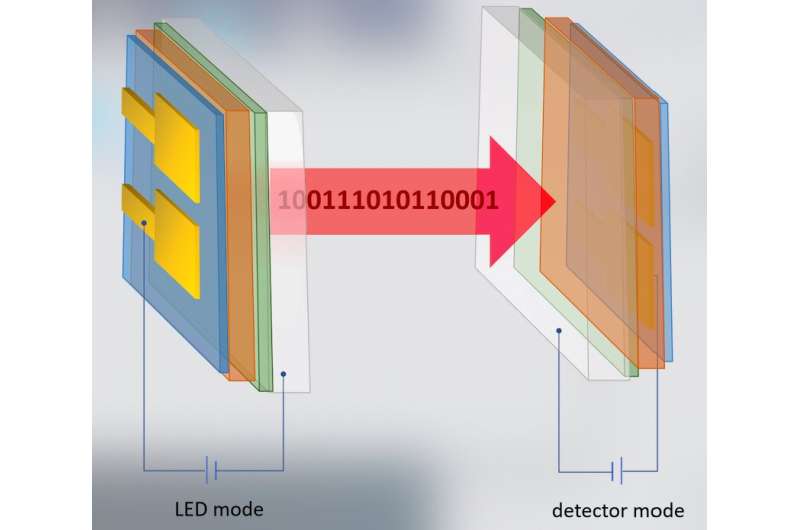Credit: Bao et al.
Light sources and detectors are key components of countless technological devices on the market today. For instance, light emitting diodes (LEDs) are often used as a source of light in displays and other technologies, while photodiodes are used to detect light in sensors, imaging and fiber optic communication tools.
Existing light sources and detectors comprise two distinct types of devices with markedly different functions. Developing a device that can both generate and detect light, however, could enable the design of smaller and smarter technologies.
Researchers at Linköping University in Sweden, Shenzhen University and several other universities in China have recently fabricated an efficient diode capable of both emitting and detecting light. This new device, presented in a paper published in Nature Electronics, was built using a solution-processed perovskite material.
"If we had a dual-functional device that could efficiently emit and detect light, we could use a single device to do the work that typically requires two conventional devices," Feng Gao, principal investigator on the study, told TechXplore. "This could not only reduce how much devices cost, but also facilitate the integration of light sources and detectors in optoelectronic chips."
In a previous study featured in Nature Photonics, Gao and his colleagues identified a mechanism known as the 'passivation effect' in perovskite films, which are emerging materials used to build LEDs. They then designed an efficient passivator (i.e., a substance that can repair the defects in semiconductor) and used it to improve the quantum efficiency of near infrared perovskite LEDs to over 21%.
"Based on this previous work, we further studied the light detection function of these devices and found that they also show remarkable photodetection performance," Chunxiong Bao, one of the researchers who carried out the study, told TechXplore. "In our recent study, we focused our efforts on simultaneously improving the light emitting and detection performance of perovskite-based diodes, demonstrating their feasibility as efficient light emitting and detection 'two-in-one' devices."
The perovskite material that Gao, Bao and their colleagues used to build their diode has several unique photoelectrical properties. In addition to a high photoluminescence quantum efficiency (PLQE), which is ideal for the development of high-performance LEDs, the material has a high absorption coefficient, enabling photodetection.
The material also exhibits a high carrier mobility and can thus be used to fabricate films of a variety of thicknesses. Finally, the researchers observed a large overlap between the perovskite's absorption and photoluminescence spectra. This means that the material can also absorb the light emitted by itself.
Combined, all of these properties enable the creation of highly performing LEDs and photodetectors, based on the same planar junction structure. In other words, these properties are what ultimately allowed Gao, Bao and their colleagues to create a single device that can both emit and detect light.
The diode they developed was found to achieve light emission with an external quantum efficiency of over 21% and a light detection limit in the subpicowatt scale. It can also attain operation speeds of tens of megahertz both when emitting and detecting light, performing remarkably well on each function. Moreover, when it is used as a detector, the device is also sensitive to the light emitted by itself.
"It is very challenging for conventional solution-processed semiconductors to use as high performance dual-functional device," Bao explained. "Take organic semiconductor and colloidal quantum dot for examples. Organic semiconductors always show very small overlap between the absorption and photoluminescence spectra, so they show weak absorption to light emitted from the same material, while colloidal quantum dot LEDs are always based on very thin quantum dot film due to the very low carrier transport property, so their light absorption is very weak."
The researchers are among the first to introduce a perovskite-based diode that can simultaneously work as a light emission and a light detection device, switching between these functions and yet performing remarkably well in both. In the future, the device they developed could be used to create smaller electronics that can be used as both light sources and detectors. In their paper, Gao, Bao and their colleagues outline two possible applications for the diode, showing how it can be used to build a monolithic heart pulse sensor and in bidirectional optical communications.
"We now plan to further improve the device's response speed and operation lifetime and study the detection performance of visible light perovskite LED to extend the application to visible light range," Bao said.
More information: Chunxiong Bao et al. Bidirectional optical signal transmission between two identical devices using perovskite diodes, Nature Electronics (2020). DOI: 10.1038/s41928-020-0382-3
Weidong Xu et al. Rational molecular passivation for high-performance perovskite light-emitting diodes, Nature Photonics (2019). DOI: 10.1038/s41566-019-0390-x
Journal information: Nature Electronics , Nature Photonics
© 2020 Science X Network
























